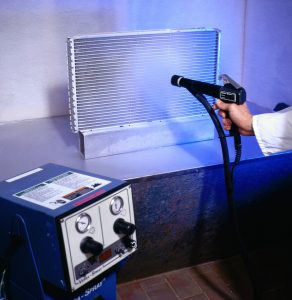Flux Characteristics and Transfer Systems in Electrostatic Application – Part 2

The background of electrostatic flux application:
When controlled atmosphere brazing with non-corrosive fluxes was introduced, the only realistic method for using the flux was wet application. This strategy was supported by the physical and chemical properties of flux powder.
Non-corrosive fluxes for aluminum brazing consist of potassium fluoroaluminates (inorganic fluorides) with low water solubility. The majority of the flux products on the market are manufactured by precipitation in aqueous solution. These show a rather fine particle size distribution, i.e. from one to fifteen micrometers (1 – 15 µm) for most of the grains (50% and more) and reaching from 0.5 – 50 µm with an average particle size between four and ten micrometers (4 – 10 µm). This type of powder is ideal for slurry application, as the fine particles prevent the flux from settling too fast. Also, when sprayed on a clean surface under wettable conditions, they present a uniform, very thin and fully adhesive coating after drying. As mentioned earlier, the flux slurry needs to be agitated continuously and the concentration must be monitored in order to guarantee consistent flux loading (i.e., flux weight per surface area).
The most significant problem in wet application is waste water. With stricter requirements and limitations for trace impurities in waste water, the pressure to reduce water consumption increases. At the same time, production capacity is expanding worldwide. Waste water treatment is expensive, and some brazing operations have limited experience in this field. In addition, more and more facilities are constructed in areas where water appropriately treated for flux slurry preparation is scarce and costly.
The challenges of electrostatic flux application:
Electrostatic powder coating has been standard technology for many years, and it was only a question of time before it was also realized in flux application. The following will focus on essential flux properties and basic equipment arrangements.
Some material characteristics of non-corrosive brazing fluxes make it difficult simply to transfer the normal powder coating equipment to the fluxing area and use it there. Most powders utilized for electrostatic application are either designed with special properties or already contain them. Important elements are:
- Particle shape and particle size distribution
- Ability to accept and to hold electrical charge
Particle size distribution has a significant influence on the ability of a powder to fluidize and to flow. Better fluidization characteristics lead to better equipment performance. Consistent flux transfer and the ability to flow through pipes and plastic hoses is directly affected by fluidization. Additionally, it has been observed that good fluidizing material shows less tendency to build up in the equipment. Buildup can quickly result in interruptions of the flux flow. When this buildup is expelled the nozzle may release an excessive amount of flux. This excess will in turn be deposited on the surface of the part, resulting in non-uniform flux distribution. It is possible to induce charge on flux when it travels through an electrical field. However, the powder, by its chemical and physical nature, displays instantaneous charge decay when it hits the grounded heat exchanger. Therefore, the forces that adhere the flux to the part are not electrostatic forces, but are more likely Van der Waals forces. In dry flux application, the following complications have been described by users when operating conventional flux qualities:
- Fluidizing the powder and material transport is difficult. Vibration or stirring is necessary to improve on these characteristics
- Problems with consistency of flux flow and uniformity of applied flux
- Adhesion of deposited flux is inferior when compared with wet application
- High humidity causes physical adsorption of water molecules to the fine powder dust in the booth. This may result in agglomerations
- Recovering, recycling and reusing flux requires special attention
To be continued …

Hinterlasse einen Kommentar
An der Diskussion beteiligen?Hinterlasse uns deinen Kommentar!